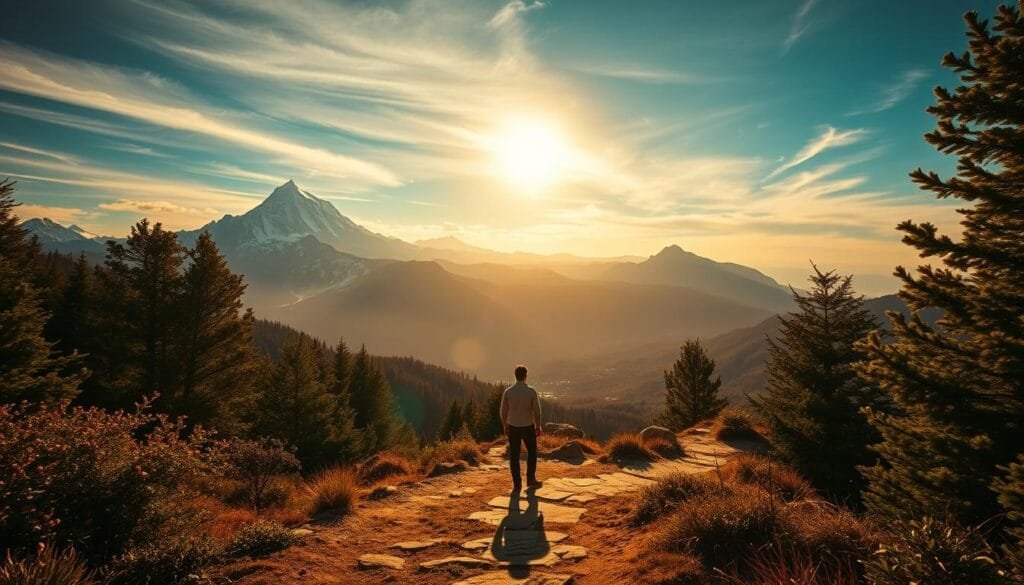Have you ever looked through old vacation photos and felt they didn’t capture the magic you experienced? That sunset in Santorini that took your breath away now looks flat. The bustling Moroccan market that buzzed with energy appears static. This gap between memory and image is where true artistry begins.
Great visual storytelling isn’t about fancy gear or perfect lighting—it’s about connecting with your surroundings. National Geographic photographers succeed because they study locations deeply before clicking the shutter. They seek the soul of a place, not just its landmarks.
This guide helps you develop that same intentional approach. You’ll learn how to transform random shots into cohesive narratives. Discover why researching local culture matters as much as understanding your camera’s settings. We’ll explore techniques to preserve not just sights, but the feeling of being there.
Key Takeaways
- Professional-grade images require understanding a destination’s unique atmosphere
- Technical skills work best when paired with emotional awareness
- Preparation turns chaotic moments into purposeful compositions
- Every photograph should tell a story about the location’s character
- Balancing creativity with camera mastery creates standout work
- Images that evoke memories outperform generic tourist snapshots
Understanding the Essence of Travel Photography
Every destination whispers its story through textures, colors, and rhythms waiting to be framed. Your camera becomes a bridge between fleeting moments and lasting memories when you focus on what makes a location breathe.

Capturing the Spirit and Ambiance of Each Destination
Notice how morning light dances across ancient walls differently than afternoon shadows. Observe patterns in street vendors’ movements or the way wind shapes dunes. These details form a place’s fingerprint. “Your first hour in a new location holds raw magic,” says National Geographic contributor Amy Sanders. “Document that initial spark before your brain organizes it.”
| Technical Element | Emotional Counterpart |
|---|---|
| Lighting adjustments | Mood interpretation |
| Focus settings | Cultural context awareness |
| Exposure control | Sensory memory triggers |
Valuing First Impressions and Emotional Connectivity
Jot down three sensations within five minutes of arriving somewhere new. Was it the crisp mountain air? Laughter echoing through alleyways? This practice keeps your work authentic. Your early reactions often reveal what truly matters about a scene.
Try this exercise next trip:
- Close your eyes upon arrival for 30 seconds
- Note dominant sounds/smells first
- Photograph what your gut finds intriguing
This approach helps you see with fresh eyes, even in crowded tourist spots. Later, these elements become anchors that transport viewers beyond pixels on a screen.
Researching Your Travel Destination
Great shots are made long before you press the shutter—through meticulous research. National Geographic contributors often spend weeks studying a location’s geography, traditions, and visual potential. This groundwork transforms random snaps into purposeful storytelling.

Leveraging Guides, Brochures, and Online Resources
Start with physical postcard racks at visitor centers. These curated images reveal what locals consider iconic. Pair them with Google Image Search to spot seasonal variations. One photographer shares: “Postcards show the classics—social media reveals how light interacts with those scenes at different times.”
Create a hybrid shot list using:
- Library archives for historical context
- Embassy websites for event calendars
- Pinterest boards to analyze color palettes
Gathering Local Insights and Cultural Background
Understanding a region’s etiquette unlocks hidden opportunities. In Japan, asking permission before photographing shop displays builds trust. In Morocco, knowing prayer times helps plan shoots around bustling markets.
| Research Method | Creative Benefit |
|---|---|
| Local festival guides | Captures unique traditions |
| Weather pattern analysis | Predicts golden hour clarity |
| Community forums | Reveals photo-restricted zones |
Chat with hotel staff about lesser-known viewpoints. Their knowledge often surpasses guidebooks—and costs nothing but genuine curiosity.
Essential Travel Photography Tips
Light doesn’t just illuminate—it sculpts emotion into every frame. Professionals know dawn’s golden glow reveals textures that midday sun flattens. “Arrive before the crowd, and you’ll photograph a location’s true personality,” says Nikon Ambassador Lisa Chen. Set two alarms if needed—those quiet morning moments often yield your strongest work.
Keep your gear accessible and charged. Unexpected magic happens when you’re ready:
- A street performer’s spontaneous dance
- Sun rays breaking through storm clouds
- Local interactions that reveal cultural character
| Technical Focus | Creative Mindset |
|---|---|
| Exposure settings | Observing human patterns |
| Lens selection | Anticipating action |
| Battery management | Embracing imperfections |
Balance structure with flexibility. Scout locations beforehand but leave room for detours. That unplanned alleyway mural or bustling café might become your trip’s highlight reel. Patience separates snapshots from storytelling—wait for elements to align rather than forcing compositions.
Develop observational habits that transform ordinary scenes. Notice how shadows shape architecture or how vendors arrange colorful produce. These details become visual anchors that transport viewers to your viewpoint. Remember: Great images aren’t taken—they’re made through awareness and timing.
Mastering Camera Settings and Techniques
Your camera holds untapped potential waiting to be unlocked. While automatic modes work for quick snaps, manual control transforms ordinary scenes into extraordinary images. Think of ISO, aperture, and shutter speed as three dancers moving together—when synchronized, they create perfect exposure harmony.
Understanding Manual Mode: ISO, Aperture, and Shutter Speed
Start with aperture—the eye of your lens. Lower f-numbers (like f/2.8) blur backgrounds to spotlight a market vendor’s weathered hands. Higher f-numbers (f/16) keep entire mountain ranges crisp. Shutter speed freezes hummingbird wings at 1/2000s or streaks city lights at 1/4s.
ISO balances light sensitivity with clarity. Keep it under 800 for sunlit landscapes to avoid grain. Bump it to 3200 in dim cafes to capture authentic local life. “Manual mode isn’t about complexity—it’s creative freedom,” explains Canon Explorer Rachel Torres.
Smartphone vs DSLR: Maximizing Your Equipment’s Potential
Modern smartphones excel in portability and AI-enhanced shots. Use them for:
- Candid street scenes where bulky gear draws attention
- Quick HDR blends in changing light conditions
- Experimental angles using compact size
| Tool | Best For |
|---|---|
| DSLR | Low-light landscapes |
| Smartphone | Discreet cultural moments |
Many photographers now scout compositions with their phone before setting up tripods. Your gear should serve the moment—not limit it. Pair a DSLR’s depth control with a phone’s instant sharing capabilities to cover all creative needs.
Composing with the Rule of Thirds
Imagine your camera screen as a tic-tac-toe board that guides where to position visual elements. The Rule of Thirds transforms snapshots into deliberate compositions by creating natural balance. This technique splits your frame into nine equal sections using two horizontal and vertical lines.
Using Grids to Balance Your Composition
Activate your camera’s grid overlay in settings—it’s like training wheels for better framing. Place horizons along the top or bottom line to avoid splitting landscapes. Position a market vendor’s face at intersecting points to draw attention naturally.
Centered subjects often feel stiff. Try these adjustments:
- Align winding roads with vertical grid lines
- Place eyes in portrait shots along the top third
- Let crashing waves fill the lower third of seascapes
| Centered Composition | Rule of Thirds |
|---|---|
| Predictable symmetry | Dynamic tension |
| Static energy | Guided eye movement |
Seasoned shooters know when to break rules. A perfectly centered temple shot works if reflected in water. But master the grid first—it teaches you why deviations matter. Your images gain purpose when every element earns its place.
Creative Use of Angles and Perspectives
Your camera position shapes reality more than you realize. While most snapshots happen at eye level, creative perspectives transform ordinary scenes into visual adventures. This approach turns ancient ruins into towering giants and busy streets into abstract patterns.
Experimenting with Different Angles and Lenses
Start by shooting the same subject three ways: low, high, and sideways. Crouch near a cobblestone path to make cracks look like canyons. Climb stairs to photograph markets as colorful mosaics. Wide-angle lenses stretch space, making cathedral arches soar. Telephoto options compress distances, stacking mountain layers like paper cutouts.
| Lens Type | Perspective Effect |
|---|---|
| 24mm wide-angle | Exaggerates foreground depth |
| 85mm portrait | Flatters human subjects naturally |
| 200mm telephoto | Makes distant elements interact |
Enhancing Depth with Foreground, Midground, and Background
Add dimension by framing through objects. Shoot between flower petals toward a distant castle. Position a bicycle wheel (foreground) beside a café (midground) under swirling clouds (background). This layering technique pulls viewers into your frame.
Zoom lenses offer magical tricks. At 200mm, a farmer’s silhouette might align perfectly with a setting sun miles away. These optical illusions create relationships between elements that don’t exist in reality. “Perspective is the photographer’s superpower,” says Sony Artisan Chris Carter. “It lets you redesign the world through positioning.”
Challenge yourself: capture ten versions of one scene. Each iteration reveals new possibilities. That weathered door? Photograph it head-on for symmetry, then from the side to highlight peeling paint textures. Your best shots often come when you push past obvious solutions.
Maximizing Natural Light: Golden and Blue Hours
Sunlight paints the world differently when the clock nears dawn or dusk. These transitional periods offer colors you can’t replicate with filters—nature’s own magic hour. Understanding these windows transforms how you document places, adding depth and mood that midday shots often lack.
Shooting During Golden Hour for Warm Tones
That hour after sunrise or before sunset bathes everything in honeyed light. Warm tones make stone walls glow and skin radiate. Position the sun behind your subject to create halos around hair or architectural details. Watch how long shadows add drama to flat landscapes.
Utilizing Blue Hour for Cool, Ethereal Shots
Twilight’s cool tones work wonders for cityscapes and water reflections. Capture neon signs popping against indigo skies or moonlight kissing mountain peaks. Use longer exposures to blur moving clouds or traffic trails. A sturdy tripod becomes essential here.
Keep weather apps handy—cloud cover amplifies these effects. Arrive early to scout angles, then let natural light rewrite the scene minute by minute. Your patience will mirror the earth’s rotation, resulting in frames that feel both fleeting and timeless.
FAQ
How do I capture the true vibe of a place?
Focus on details that evoke emotion, like local interactions or unique textures. Observe how light changes throughout the day and let those moments guide your shots. Authenticity comes from immersing yourself in the environment.
Why is manual mode important for better results?
Manual control lets you adjust ISO, aperture, and shutter speed to match conditions. For example, lowering ISO reduces noise in bright settings, while widening the aperture blurs backgrounds for portraits. Practice helps you adapt faster.
Can smartphones compete with DSLRs for quality?
Modern phones excel in convenience and AI-enhanced features like night mode. Use them for quick snaps or tight spaces. DSLRs still shine in low light or when capturing fast action, thanks to larger sensors and lens options.
What’s the easiest way to improve composition?
Turn on your camera’s grid feature. Place key elements where the lines intersect—like a horizon on the lower third or a subject off-center. This creates balance without overcomposing.
How do angles change a photo’s impact?
Shooting low emphasizes scale, like making mountains loom. High angles simplify cluttered scenes. Try tilting your device slightly for dynamic energy in street shots or architecture.
When is the best time to shoot outdoors?
Golden hour (just after sunrise/before sunset) adds warmth and soft shadows. Blue hour (twilight) offers cool, even tones for cityscapes. Both times reduce harsh contrasts compared to midday sun.